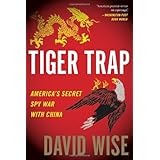
Average Reviews:

(More customer reviews)David Wise writes with direct, swiftly moving prose and adds new information to the record; however, the analysis of Chinese intelligence activities is flawed and readers will not be able to place Chinese intelligence activity into context after studying this book.
Wise contributes new information in a couple of areas. He adds more detail about Gwo-Bao Min (Tiger Trap) than was previously available and weaves together the disparate threads connecting Chinese espionage allegations on West Coast. Wise fills in some of the gaps left in previous treatments. Wise also pulls together a good deal of information on the recent espionage cases in the last five years, which would only be available to a lay reader after several hours of research.
Unfortunately, Wise chooses not to take a step and look at the information he so assiduously collected. Instead, he relies on retired FBI agents, who repeat old platitudes about Chinese intelligence methods----platitudes that may never have been true to begin with. This might be tolerable if Wise himself had not collected a lot of data contradicting his opening chapter. Most Western observers believe Chinese intelligence methods are wildly different than Western or Russian models. They think, among other points, China relies on amateur collectors rather than professional intelligence officers, does not pay for secret information, and does not develop formal intelligence relationships.
Yet Wise charts the tale of the Chinese intelligence officer at the heart of recent espionage cases, involving Chi Mak, Kuo Tai-shen, James Fondren, and Gregg Bergersen. Chinese intelligence recruited these sources and paid them in exchange for US defense secrets. Why did they spy? Greed. Venality. One might be tempted to forgive Wise's reliance on out-dated analysis if these were new developments. However, Wise also provides a short summary of the Larry Wu-Tai Chin case, who spied from the 1940s to 1985. The Chin case looks and feels like one of the many cases run across the NATO-Warsaw Pact divide.
No coverage of Chinese intelligence today would be complete without a section on cyber (hacking), but there is little in Wise's treatment to commend. The cyber chapter is a summary of news clippings and official commentary. For better analyses of Chinese cyber activity, academic and policy journals, like Survival (IISS) and International Affairs, offer accessible (jargon-free) and thoughtful treatments that put Chinese cyber in perspective.
Ultimately, Tiger Trap is a good read with some new information about Chinese espionage cases; however, it is unsatisfying for anyone looking for anything that goes beyond the headlines. If there were more choices for reading about Chinese intelligence, this book would probably only rate 2/5 stars. There are, unfortunately, few alternatives to Wise's book and he should be recognized for mostly sticking to facts in the espionage cases. This redeeming feature makes Tiger Trap a useful reference guide and the clean writing makes it an easy read.
Click Here to see more reviews about: Tiger Trap: America's Secret Spy War with China
Click here for more information about Tiger Trap: America's Secret Spy War with China

0 comments:
Post a Comment